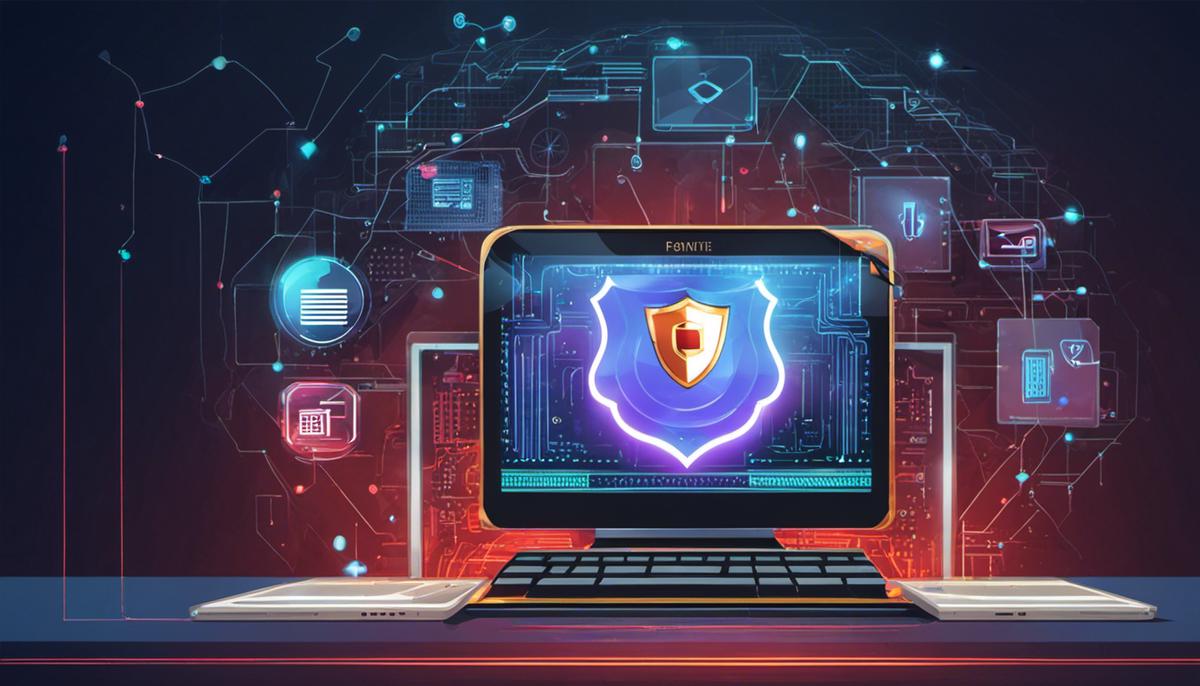As we traverse the era of digital revolution, events in cyberspace have an increasing impact on the lives of individuals and the existence of enterprises. In this interconnected world, malicious players utilize technology to orchestrate attacks, posing a significant threat to our digital existence. This discussion examines the varied forms of such cyber threats, including but not limited to phishing, ransomware, and even AI-driven dangers. It further quantifies the enormity of damages engendered by cyber-attacks, establishing the monetary and reputational costs firms contend with. We then delve into the various defense mechanisms employed by organizations, exploring the functionality and efficiency of tools like firewalls, intrusion detection systems, and encrypted data transmissions. Lastly, we emphasize the integral role of cyber hygiene in bolstering security and glance towards the future, scrutinizing the evolving threat landscape and imminent technological advancements in cyber security.
Understanding Cyber Security Threats
Unraveling Today’s Pervasive and Emerging Cybersecurity Threats
In today’s digital age, where technology continually evolves at warp speed, and data is king, cybersecurity threats pose serious risks to businesses and individuals alike. As more people grow increasingly dependent on online systems across various aspects of life, hackers and cyber-attackers are also stepping up their game, launching sophisticated schemes with potentially damaging ramifications. By identifying the most common cybersecurity threats, as well as those on the horizon, individuals can fortify their defenses and shield their sensitive data.
First and foremost, Phishing, a classic yet still-powerful tactic, deserves attention. Leveraging trust through disguised emails or websites, attackers trick victims into providing sensitive personal information. Though not a new phenomenon, it is reaching new heights with advancements in social engineering, making it more difficult for users to discern scams from legitimate requests.
Ransomware is another conventional yet hard-hitting cybersecurity threat. This vicious software essentially “kidnaps” a user’s files and data, releasing them only after a ransom has been paid. With more businesses vastly reliant on digital systems, the entrapment and subsequent release of vital files can cripple operations and result in significant monetary losses.
Next on the list is the ubiquitous Malware – software created to damage or infiltrate a system without the user’s consent. Varied in nature, it includes Trojans, viruses, worms, and the aforementioned ransomware. Its deployment revolves around disrupting and gaining unauthorized access to systems, normally leading to theft or damage of data.
While these threats are most common, let’s focus on emerging challenges. One often overlooked issue is the insecure Internet of Things (IoT) devices. More devices are being connected to the internet than ever before, from smart fridges to security cameras and even vehicles. Unfortunately, many manufacturers prioritize convenience over security, presenting entry points for crafty attackers.
Finally, an upcoming threat to watch out for is AI-powered attacks. While artificial intelligence proves transformative in enhancing cybersecurity, it simultaneously opens Pandora’s box. Skilled attackers harness AI to launch highly sophisticated cyberattacks, making traditional response and defense mechanisms ineffective.
In conclusion, as our dependency on technology grows, the landscape of cyber threats shifts and expands. It’s nuanced, layered, and evolving with every breakthrough, but being informed about the common and emerging threats is the first line of defense. Therefore, it’s crucial to maintain robust cybersecurity practices, invest in top-tier protection software, and stay informed about the ever-adapting strategies and tactics of cyber attackers.

Impacts and Costs of Cyber Attacks
Delving into the Influences and Estimated Fiscal Repercussions of Cyber Criminality
The relentless drums of the digital age beat on, but not without some discordant beats. Among these, cyber-attacks stand as one of the most potent threats in the technological panorama. Having discussed phishing and ransomware attacks, malware, insecure Internet of Things (IoT) devices, and AI-powered attacks in a previous article, it’s now vital to consider the ensuing impacts of these invasions on a wider scale and approximate the economic losses they induce.
First and foremost, cyber-attacks precipitate steep financial burdens. Arguably, financial institutions find themselves most susceptible due to their data-laden operations and vast cash flows. However, any business, regardless of its size or nature, can face sizable financial losses if targeted. Statistically, the average cost of a data breach in 2020 was $3.86 million – an alarming figure that emphasizes the seriousness of these threats.
Cyber-attacks also cause significant operational disruptions. Denial of Service (DoS) attacks, in particular, can bring online resources to a grinding halt, obstructing user access, creating accessibility issues, and slowing performance. The impacts escalate further, often resulting in a loss of business continuity and necessitating hefty expenditures to re-establish effective operations.
In the shadow of cyber-attacks, corporate reputations often wilt. Following a breach, trust wanes, customer relationships falter, and the company’s image suffers a significant blow. Rebuilding a brand’s reputation post-attack is not merely time-consuming but also costly, with tangible impacts on sales and revenue.
Interestingly, cyber-attacks can impact national security. Nation-states now leverage these digital weapons, leading to erosion of social and economic structures, disruptions of critical infrastructures, and even threats to national defense mechanisms.
Quantifying these impacts into a definite cost is complex, but research and statistical analysis can provide ballpark figures. Accenture’s 2019 “Cost of Cyber Crime” study outlines that the average cost of cybercrime for an organization increased from $1.4 million to $13.0 million over the preceding five-year period. Moreover, Juniper Research predicts that the total cost of data breaches may rise to $2.1 trillion globally by 2023.
In the face of these numbers, investing in strong cybersecurity measures is not merely essential; it’s an absolute imperative. As tech enthusiasts, let us lead the way in championing robust cyber defenses, advocating for well-informed cyber practices, and continuing the exploration of this ever-evolving digital landscape.

Cyber Security Defense Mechanisms
Defending against cyber-threats: Advanced Strategies
As the problem of cyber threats continues to expand, so too must the strategies to combat them. The modern landscape of cybersecurity has evolved to include robust security systems, strong practices, and developing norms -but they won’t suffice anymore. The insurgence of evolving technologies and the increasing complexity of cyber-attacks necessitate adopting advanced approaches as part of a comprehensive cybersecurity strategy.
- Two-Factor Authentication: The stakes are high, and it requires more than a password to defend data. Two-factor authentication (2FA) adds an additional protective layer. It is a method wherein a user’s claimed identity is authenticated by using a combination of two different components. Generally, these incorporate something the user knows and something they possess.
- Firewalls: Firewalls continue to be an essential part of defense strategy against cyber threats. They monitor incoming and outgoing network traffic based on predetermined security rules and act as a barrier between a trusted and an untrusted network.
- Encryption: Encryption does not prevent intrusion, but it makes the intercepted data virtually useless to the attacker. It safeguards data at rest and data in transit, adding an extra layer of security. The surge of end-to-end encrypted messaging apps signifies the importance of this method.
- Intrusion Detection/Prevention Systems: These tools monitor network and/or system activities for malicious actions or policy violations and produce reports to a management station. It acquires knowledge from previous attacks and incorporates mechanisms to predict future ones.
- Backup Systems: Regular back-ups of critical data ensure its availability even after a major cyber-attack. Stored in an offsite location, the backed-up data is immune to the most devastating attacks as it won’t be connected to a compromised system.
- Hardware-based Authentication: It’s a method that facilitates measuring the integrity of devices and infrastructure. Authenticating hardware devices augments the security of the system by firmly identifying the user utilizing the device.
- Network Segmentation: Segmentation splits a network into multiple networks, each accessible only through defined rules. If a cyber attacker infiltrates one segment, this measure confines their access to just that section.
- Threat Intelligence: It provides actionable information about existing or emerging threats. Companies can employ it to align their security measures with ever-advancing threats, optimize their response, and bolster their resilience against cyber-attacks.
- Privacy-by-Design: This approach involves considering privacy issues at the designing phase of any system, service, product or process. It embeds a privacy-protective infrastructure, reducing the chances of later patches and fixes.
- Regular Security Training: As human error is common in data breaches, regular training turns employees into the first line of defense, recognizing and mitigating cyber threats proactively.
Defenses against cyber threats are a continually evolving arena. To stay ahead, constant vigilance, advanced strategies, and the willingness to adapt are imperatives. Consider these defense mechanisms not as mere protective measures but as absolute necessities in the war against cybercrime.

Importance of Cyber Hygiene
Let’s dive straight into the crux of why cyber hygiene isn’t just important; it’s crucial. Cyber threats are ubiquitous in today’s increasingly digital world, posing severe risks to personal data as well as the business operations of organizations. Yet, practicing good cyber hygiene can significantly reduce these risks. Forget about mere protection; cyber hygiene is the bulwark against the ever-evolving, stormy seas of cyber threats.
Consider this: primarily, two types of breaches pose a threat: known and unknown. Known vulnerabilities are those which have already been discovered and can be patched or mitigated against. Most of them, around 99% (as per various industry reports), can be prevented with cyber hygiene protocols. So yes, preventive measures, like regular updates and patching, matter a lot.
Conversely, unknown vulnerabilities – the elusive 1% – are novel exploits not yet discovered. These often fall under the category of zero-day exploits, which are attack vectors that exploit a vulnerability on the same day it becomes known. It’s the latter category that the majority fears and hence extrapolates this fear to the entire security landscape.
But in practice, it’s the known vulnerabilities that wreak the most havoc due to the lack of cyber hygiene, like delayed patches and updates, weak passwords, unused accounts, exposed services, etc. In essence, a structured and consistent approach towards cyber hygiene can effectively checkmate the overwhelming majority of risks.
Multiple factors contribute to proper cyber hygiene, including regular software updates, controlled use of administrative privileges, application white-listing, proper password management, and more. Automated software updates and patches ensure that known vulnerabilities are not exploited.
Furthermore, robust password management reduces the chances of unauthorized access while limiting administrative privileges restricts the potential damage in case of a security breach. Application whitelisting only allows pre-vetted and known applications to run, thus preventing potentially harmful programs from executing. Implementing these steps is relatively straightforward but reaps exponential benefits in fortifying your cyber defense.
Specific cyber hygiene protocols for organizations include having separate networks for different operations – a practice known as network segmentation. It reduces the impact of a potential breach by prohibiting it from spreading across the entire network.
Moreover, organizations should practice routine audits and vulnerability scanning to stay aware of their security posture, patching vulnerabilities as they’re discovered. Educating employees about possible threats and teaching them to recognize phishing scams, dubious links, or sites can make a vast difference too. After all, human error has often been the weak link in cybersecurity.
Taking a step further, implementing advanced methods such as Hardware-based Authentication and Threat Intelligence platforms offers additional layers of security. They not only provide enhanced protection but also foresight about upcoming threats, enabling proactive defensive steps.
In conclusion, cyber hygiene is not just about staying a step ahead in the cybersecurity game. It’s about maintaining robust defense lines that can mitigate the risks from the majority of common cyber threats, offering peace of mind in a chaotic landscape. A regular, disciplined approach to cybersecurity can do wonders for individuals and organizations alike, especially in an era when digital real estate is under perennial threat. Adopting and maintaining cyber hygiene should not be an option but rather the norm.
When it comes to cyber threats, prevention is not just better than cure; it’s indispensable. Overlooking cyber hygiene is not worth the risk. So, let’s be smart, stay updated, and stay safe!

The Future of Cyber Security
Building a Predictive and Proactive Cybersecurity Framework
There is an increasing need for predictive cybersecurity mechanisms in today’s technologically focused world. Existing defensive measures and cyber hygiene practices, while crucial, are only parts of a comprehensive cybersecurity approach. Future trends indicate a shift towards anticipatory measures and real-time solutions that could prove paramount in deterring cyber-attacks before they occur.
One of the most innovative and promising developments in this area is predictive analytics. By making use of machine learning algorithms and AI, predictive analytics can foretell potential vulnerabilities and anticipate potential breaches based on patterns and historical data. Rather than responding to breaches after they occur, organizations will have the ability to neutralize threats even before they crystallize.
Similarly, the concept of privacy engineering is gaining traction. This concept involves integrating privacy protections into the design phase of technologies and systems instead of adding them as supplementary features at a later stage. Privacy engineering can bolster defense capabilities, deter cyber threats, and safeguard integral data by making privacy a core foundational element.
Another area of growth is securing data in the quantum computing world. Quantum computers, with their super-fast processing power, have the potential to break traditional encryption methods. The research in the field of quantum-safe cryptography, which involves the development of encryption methods that can withstand quantum computer attacks, is progressing rapidly. It will be crucial for future cybersecurity as quantum computing becomes mainstream.
With the growing population of remote workers, demand for secure cloud technologies is higher than ever. Cloud-native security solutions are poised to play a significant role in the future of cybersecurity. These solutions cater directly to the unique needs and threats involved with cloud technology, allowing for better protection of data stored in the cloud.
The proactive and risk-based approach of Zero Trust is another future-minded strategy. The Zero Trust model operates on the “never trust, always verify” principle, recognizing that threats can come from both outside and within an organization. This model limits every user’s access to only what they need and continuously verifies each user, device, and app.
In conclusion, the future of cybersecurity will need to be agile, predictive, and seamlessly integrated into all aspects of organizational operations. The utilization of advanced technologies such as AI, quantum-safe cryptography, or secure cloud technologies will become necessities rather than luxuries. The ever-changing landscape of cybersecurity indeed presents serious challenges, but with proactive strategies and innovative solutions, these challenges can turn into opportunities for building robust security infrastructures. The only way to stay ahead is to always be ready for the next phase of the cyber race.

As we advance into a future dominated by digital processes, it’s evident that cyber security will continue to play a pivotal role in safeguarding our cyber activities. Expectantly, with technological advancements giving rise to more nuanced defense mechanisms, we can anticipate a shift in the balance of power. Yet, the dichotomy lies in the fact that the same technological progression may birth more potent forms of cyber threats. Our best bet lies not only in fortifying institutional defenses but also in cultivating a culture of strong cyber hygiene among individuals. Maintaining cyber safety is a collective responsibility and our understanding and efforts towards it today will significantly shape our digital tomorrow.
